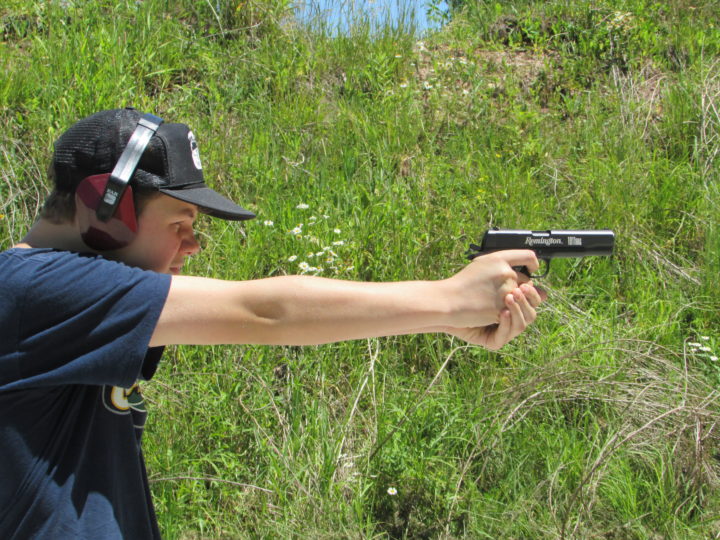By Eve Flanigan
Whether you own a semi-auto handgun for protection, competition or recreation, there are certain tasks to master in order to operate that firearm with ease and efficiency. Of course, the fundamentals of marksmanship are important, but it’s neither difficult nor uncommon for any shooter to be able to hit a target with reasonable accuracy with relatively little practice. That said, there is much more to good range-craft and proper defensive preparation than the simple act of shooting. Those who want the winner’s edge will also master gun handling.
For purposes of this article, “gun handling” refers to three skills associated with operating a semi-auto handgun, skills that will inevitably be needed at some point. I won’t provide you in-depth instruction—seek out one-one-one training from a knowledgeable instructor you’re comfortable with for that—but I’ll explain the common challenges you’re going to encounter with regular handgun use and remedies for them so you know what to expect when the inevitable happens. With this knowledge, you’ll be better able to evaluate your own progress and ask intelligent questions of your instructor when you’re ready to train on these skills.
Loading the Pistol
Inserting a magazine and racking the slide to lift a round into the chamber are the essentials of loading. It is truly a simple operation, but many new shooters, in an earnest effort to be safe, bend over and hold the gun at arm’s length to perform these maneuvers.
Being safe in the process of loading doesn’t require such awkwardness. A more global approach to safety—not to mention efficiency, which could be uber-important at some point—is to keep the muzzle of your handgun pointed in a safe direction while maintaining an upright posture. Being upright keeps the ability to be mobile and your peripheral vision intact. Keeping your upper arms at your side and your elbows bent so that the gun occupies an area about the size of a shoebox in front of you also means that you have a better chance of keeping your gun secure than if you have it way out in front of you at arm’s length. In a defensive situation, that could be life-saving. It also allows for your core strength to contribute to racking the slide, a much better approach then doing this at arm’s length where your hands and fingers are doing most of the work.
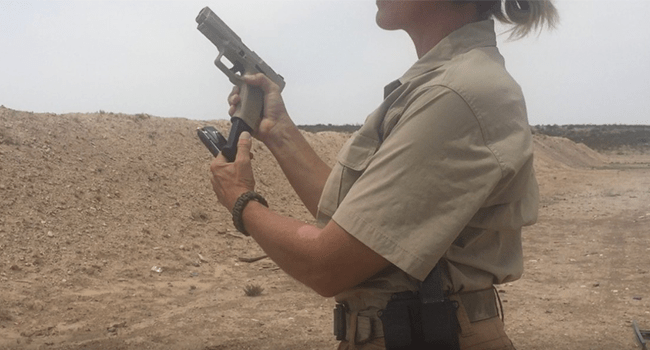
The tactical reload–reloading when it’s convenient for you rather than when the gun is completely empty–is a smart skill to be practiced in if you carry concealed for self-defense.
Into the definition of loading also falls the so-called tactical reload. That’s an exchange of a partially full magazine for a full, or fuller one, while the chamber remains loaded (i.e., the slide will be closed).
This technique is often associated with extended gun battles. In such a situation, it can certainly be advantageous to reload to full capacity when it’s convenient for you, say, during a lull in the action, when you’ve accessed temporary cover but anticipate resuming shooting shortly. That may be a much better scenario than being forced to reload because your gun’s run empty and you are perhaps without the benefit of adequate cover. Action-shooting sports such as IPSC and 3-Gun also incorporate the tactical reload from time to time in stage rules, and depending on your pistol’s capacity, a tactical reload done during movement, such as running from one bank of targets to another, can save precious seconds over the same reload done while standing still.
The requirements of certain competitions aside, it’s unlikely you’ll find yourself in a firefight of volume, so some say the tac reload isn’t a necessary skill for “regular” people to learn. But you don’t need to be the commander of a S.W.A.T. team or a Master Class IPSC shooter to find this skill valuable. Just one reason to learn the tactical reload? Magazines malfunction. Another? With practice, you’ll find yourself keeping better track of the rounds you have fired, something you might need to be aware of in the case of that unlikely gunfight.
Tip! To correctly practice a tactical reload, you’ll need to find an instructor capable of working with different ways to carry spare magazines and how to retrieve them in the most efficient way when needed. This is critical if you carry concealed because your spares won’t have extended, fluorescent-colored base pads that make them easy to find, and they won’t be arranged in an instant-grab fan around your belt and midsection like an IPSC competitor would.
Unloading the Pistol
Dropping the magazine from your gun should be almost effortless. On most semi-autos, a pushbutton on the frame near the bottom rear of the trigger guard releases the magazine. A few, mostly older models will have either a lever in line with the trigger guard or a grooved slide/pull-back button-type release at the bottom of the mag well. Regardless, you should be able to cause a mag to fall out without a fuss.
Some people get discouraged with this skill because their thumb doesn’t naturally reach the release. Good instruction can show you a safe and rapid method of disengaging the mag release no matter how short your thumbs are. If you’re left-handed with a typically right-hand-biased gun, a competent instructor will also help you decide whether it’s best to operate the mag release with your trigger finger or opt to procure a gun with ambidextrous controls.
You may find it workable to release the magazine with the thumb of their support hand. It does the job, but it’s inefficient for either competition or tactical requirements. Challenge yourself to drop your magazine as a one-handed, strong-side (trigger hand) operation. In many defense situations, you can save precious seconds by dropping that support hand away from the gun to locate the needed replacement, rather than leaving it on the gun to drop the magazine that’s in there.
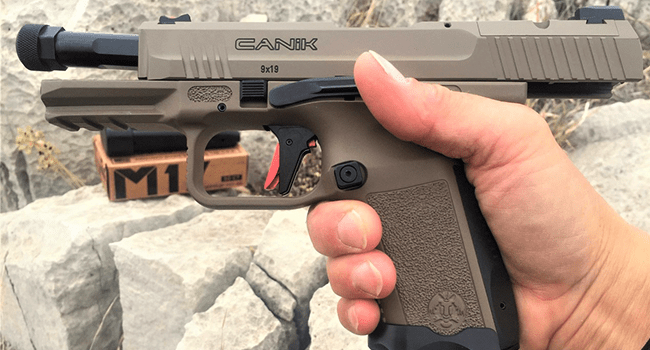
Learning how to lock the slide of you handgun open without the benefit of an empty magazine in the gun is a practical skill.
Locking back the slide without the aid of an empty magazine should be among your unloading skills, too. Slides don’t always lock open on the last-fired round, and you may need this skill to clear an un-ejected casing or forcefully eject a malfunctioning magazine. This is another skill where a well-versed instructor pays dividends. They can teach you to perform this skill without violating any safety rules.
Clearing Malfunctions
“Malfunction” is an umbrella term for the gun not going bang! when you want it to. It could be an ammunition problem, mechanical issue or operator error. No matter what it is, gun failure will happen to you eventually.
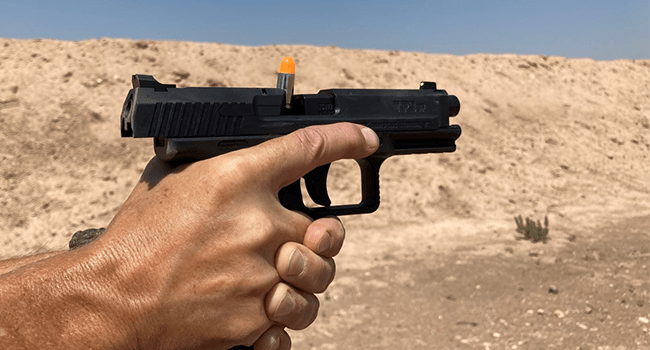
Malfunctions like a stovepipe will happen to you eventually. Practice solving this problem with dummy rounds loaded at random in your magazine.
It’s far better to encounter a malfunction for the first time in practice than in competition or combat. You can think through the steps to clear the malfunction, and with practice, those responses can become automatic—and that’s something that can save your life.
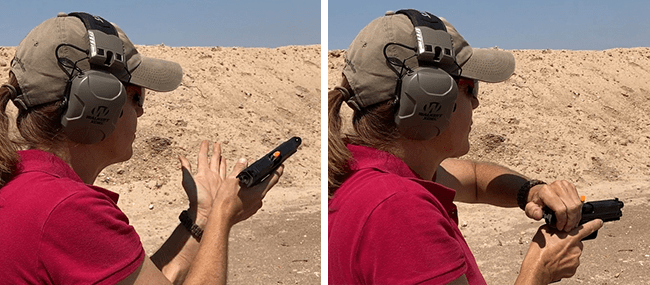
Tap and Rack–slap the magazine to make sure it’s fully seated and rack the slide to return to battery–is a common remedy for many handgun malfunctions. It won’t cure all, but being able to perform this malfunction correction quickly has benefits.
Most instructors teach tap-and-rack:
- Tap (the magazine)
- Rack (the slide) process
If that doesn’t work, forcefully removing the magazine, clearing the chamber and reloading the are the next default actions.
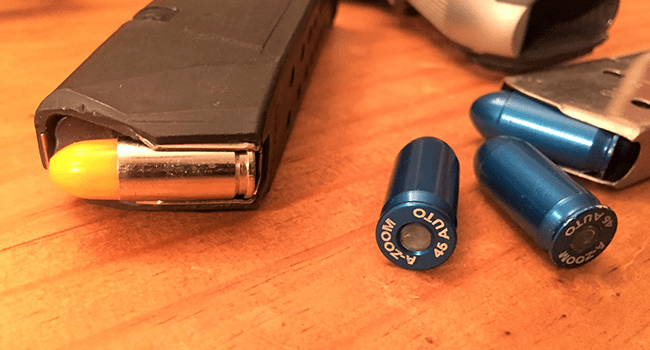
Snap caps, or dummy rounds, are useful for both dry-fire practice and for training on how to correct malfunctions.
If you’re wondering how to practice dealing with a malfunction, consider purchasing inert cartridges, a.k.a. “snap caps.” Loaded randomly in your magazine (you can have someone else load your mags to really keep it random), you’ll have no idea when the “no-bang” will happen. The more you practice such scenarios, the faster you’ll be able to remedy the problem, and you’ll do it without panicking.
Handgun Tips from NSSF
-
Stuck at Home? Train with Dry Practice – Gunsite Academy Firearms Training
-
Dry Fire Practice – Competitive Shooting Tips with Doug Koenig
-
Choosing the Right Firearm for a Beginner | National Shooting Sports Month
-
Acceptable Sight Picture – Competitive Shooting Tips with Doug Koenig
-
Equipment for Competition Shooting – Competitive Shooting Tips with Doug Koenig
-
Head & Shoulder Position – Competitive Shooting Tips with Doug Koenig
-
Shooting Stance – Competitive Shooting Tips with Doug Koenig
-
Pull The Trigger The Right Way – Competitive Shooting Tips with Doug Koenig
-
Diagnosing Accuracy Problems – Handgun 101 with Top Shot Chris Cheng
-
¿Qué Puede Esperar Cuando Va Al Polígono De Tiro? | What To Expect When Going to the Shooting Range
-
Shooting Around Barricades – Competitive Shooting Tips with Doug Koenig
-
Faster Follow-Up Shots – Competitive Shooting Tips with Doug Koenig
-
One Shot Draw Drill – Competitive Shooting Tips with Doug Koenig
-
How to Stand When Firing a Pistol: Shooting Stance – Handgun 101 with Top Shot Chris Cheng
-
How to Determine Your Dominant Eye: Aiming a Pistol – Handgun 101 with Top Shot Chris Cheng
-
Proper Trigger Pull & Dry Fire Practice – Handgun 101 with Top Shot Chris Cheng
-
Hit The First Target – Competitive Shooting Tips with Doug Koenig
-
How To Properly Grip A Semi-Auto Pistol – Handgun 101 with Top Shot Chris Cheng
-
How to Load a Magazine – Handgun 101 with Top Shot Chris Cheng
-
Understanding Caliber – Handgun 101 with Top Shot Chris Cheng
-
Pistol Shooting with Both Eyes Open – Competitive Shooting Tips with Doug Koenig
-
Rules for Safe Firearm Handling – Target Shooting 101 with Top Shot Chris Cheng
-
Stage Planning For Steel Challenge – Competitive Shooting Tips with Doug Koenig
-
The Key to Increasing Your Speed – Competitive Shooting Tips with Doug Koenig
-
Multiple Target Drills: Target Transitions – Competitive Shooting Tips with Doug Koenig
-
Handgun Speed Shooting Drill – Competitive Shooting Tips with Doug Koenig
-
Speed Up Your Draw – Competitive Shooting Tips with Doug Koenig
-
Precision Pistol Shooting – Competitive Shooting Tips with Doug Koenig
-
Weak Hand Pistol Shooting – Competitive Shooting Tips with Doug Koenig
-
Using Video to Improve Shooting – Competitive Shooting Tips with Doug Koenig
-
Finding Technique and Equipment That Works for You – Competitive Shooting Tips with Doug Koenig
-
Practice Session Dos and Don’ts – Competitive Shooting Tips with Doug Koenig
-
Goal Setting for Tournament Shooting Success – Competitive Shooting Tips with Doug Koenig
-
Holster Setup for Open Class Competition Speed Draw – Competitive Shooting Tips with Doug Koenig
-
Hit That First Shot! – Competitive Shooting Tips with Doug Koenig
-
Tools of the Trade: Equipment for Competition Shooting – Competitive Shooting Tips with Doug Koenig
-
Speed Reload: Handgun Technique – Competitive Shooting Tips with Doug Koenig
-
Dry Fire Practice: Handgun Technique – Competitive Shooting Tips with Doug Koenig
-
Sight Alignment & Sight Picture – Competitive Shooting Tips with Doug Koenig
-
Trigger Press & Trigger Control – Competitive Shooting Tips with Doug Koenig
-
Stance for Action Pistol Shooting | Competitive Shooting Tips with Doug Koenig
